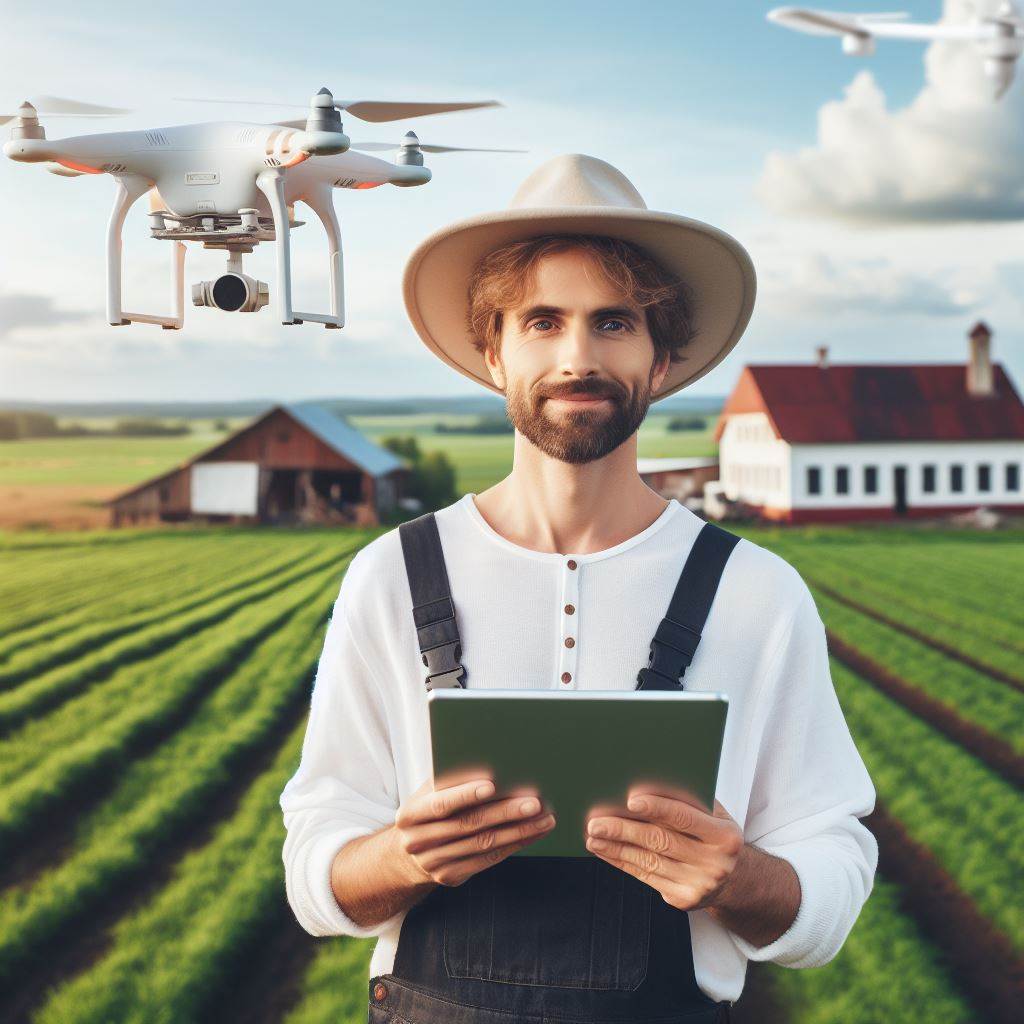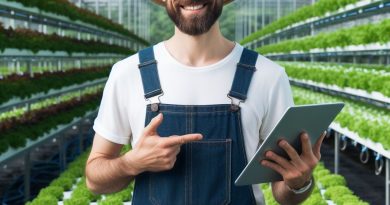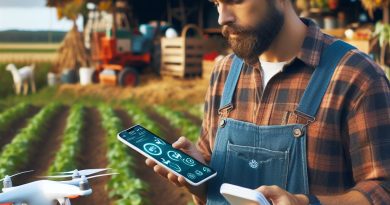Drone Tech in Agriculture: A Game Changer
Last Updated on February 10, 2024
Introduction
Drone technology, with its versatile applications, has become a revolutionary force in various industries.
This blog post will explore how drone tech is reshaping the world of agriculture.
Drones, unmanned aerial vehicles, have rapidly gained popularity due to their ability to perform a wide range of tasks remotely.
In the context of agriculture, drones are being used to revolutionize crop management, livestock monitoring, and even the spraying of fertilizers and pesticides.
By utilizing high-resolution cameras and sensors, drones can capture valuable data about crop health, nutrient levels, and irrigation needs.
This information allows farmers to make informed decisions, optimizing their farming practices and maximizing yield.
Additionally, drones equipped with thermal imaging cameras can detect anomalies, such as water stress or pest infestations, enabling early interventions and preventing crop damage.
Furthermore, drones provide an efficient solution for monitoring livestock, reducing labor costs, and improving animal welfare.
Apart from data collection, drones are also being employed for precision spraying, applying fertilizers and pesticides precisely where needed, minimizing environmental impact.
The use of drones in agriculture offers immense potential, including increased productivity, reduced costs, and minimized environmental footprint.
Moreover, they save time and resources, allowing farmers to focus on important tasks and make critical decisions promptly.
In the following sections, we will delve deeper into the specific applications of drone technology in agriculture, highlighting the transformative impact it has on the industry.
Benefits of Using Drones in Agriculture
Drones have emerged as a game changer in the field of agriculture, revolutionizing the way farmers operate and manage their crops.
With advanced technology and capabilities, drones offer numerous benefits that enhance efficiency and sustainability in agricultural practices.
Increased Efficiency and Accuracy in Crop Monitoring and Analysis
- Drones equipped with high-resolution cameras and sensors provide detailed and real-time information about crop health and growth.
- These aerial robots enable farmers to identify crop diseases, nutrient deficiencies, and irrigation problems early on, allowing for timely interventions.
- With the ability to cover larger areas in a shorter amount of time, drones can monitor crops more frequently and accurately than traditional methods, leading to better decision-making and improved productivity.
Reduction in Time and Labor Costs
- Drones automate various tasks that would otherwise require manual labor and extensive time investment.
- They streamline processes such as crop assessment, mapping, and spraying, reducing the need for large labor forces and saving valuable time for farmers.
- By minimizing time spent on crop monitoring and data collection, farmers can allocate their resources more efficiently and focus on other aspects of their operations.
Improved Crop Yield and Quality
- By closely monitoring crops and detecting issues at an early stage, drones facilitate prompt action, preventing yield loss and preserving crop quality.
- With precise data gathered from drones, farmers can optimize irrigation, fertilization, and overall crop management strategies, resulting in increased crop yield and improved overall quality.
- Drones also aid in the identification of ideal harvesting times, ensuring that crops are picked at their peak, maximizing yields and delivering superior produce to the market.
Minimized Environmental Impact Through Targeted Pesticide Use
- Drones equipped with specialized sensors and software enable farmers to precisely target areas requiring pesticide application.
- This targeted approach minimizes excessive pesticide use, reducing the environmental impact and improving sustainability in agricultural practices.
- By using drones for pesticide application, farmers can avoid spray drift and reduce the risk of chemical exposure to crops, humans, and surrounding ecosystems.
Enhanced Livestock Management and Monitoring
- Drones offer valuable assistance in managing livestock by providing aerial surveillance and monitoring.
- They allow farmers to monitor grazing patterns, identify escaped or injured animals, and assess herd health without the need for manual inspection.
- With drones, farmers can efficiently locate and manage their livestock, ensuring the well-being and safety of their animals.
In short, the use of drones in agriculture brings numerous benefits that positively impact efficiency, sustainability, and productivity in farming practices.
By utilizing these aerial robots, farmers can monitor and analyze crops with greater accuracy, reduce time and labor costs, improve crop yield and quality, minimize environmental impact, and enhance livestock management.
With their advanced capabilities, drones have unquestionably become game changers in the agricultural industry.
Read: The Rise of Smart Farming Technologies
Various Applications of Drones in Agriculture
Drones have revolutionized the agricultural industry with their versatile applications and transformative capabilities.
From crop monitoring and scouting to precise agricultural practices, these unmanned aerial vehicles are changing the game for farmers worldwide.
Crop monitoring and scouting
Crop monitoring and scouting are essential tasks in agriculture. Drones equipped with advanced sensors and cameras can provide farmers with real-time information about their crops.
By flying over fields and capturing images, drones can detect diseases and pests at early stages, allowing farmers to take necessary action promptly.
This technology saves time, money, and resources that would otherwise be spent on manual scouting.
Precision agriculture and variable rate application
Precision agriculture is another area where drones excel. With the ability to fly low and capture high-resolution images, drones enable farmers to implement variable rate applications.
By analyzing the collected data, drones can identify areas of the field that require specific attention, such as additional fertilizers or pesticides.
As a result, farmers can optimize the use of resources, minimize waste, and maximize yield potential.
Irrigation management
Irrigation management is crucial for efficient water usage in agriculture.
Drones equipped with sensors can monitor soil moisture levels and analyze crop water stress.
This data allows farmers to make informed decisions about irrigation scheduling and minimize water waste.
By using drones for irrigation management, farmers can reduce their environmental impact and conserve water resources.
Planting and seed dispersal
Drones can also contribute to planting and seed dispersal. With their precision and accuracy, drones can plant seeds at specified locations or disperse beneficial insects to enhance crop pollination.
This capability not only increases farming productivity but also reduces manual labor and associated costs.
Livestock management and monitoring
In livestock management and monitoring, drones play a vital role in ensuring the well-being of animals.
By using drones, farmers can easily locate and monitor livestock, saving time and effort.
Drones can identify injured or missing animals, allowing farmers to provide timely medical attention.
Additionally, drones can assess pasture condition, helping farmers make informed decisions regarding grazing management.
Disease detection and early intervention
Disease detection is a crucial aspect of crop management. Drones equipped with thermal imaging and multispectral cameras can detect diseases at early stages by analyzing variations in plant temperature and reflectance.
By identifying diseases early on, farmers can implement targeted interventions, preventing further spread and minimizing crop losses.
In fact, drones have become a game changer in agriculture due to their various applications.
From crop monitoring and scouting to precise agricultural practices, drones provide valuable data and insights that help farmers improve productivity, optimize resource usage, and enhance sustainability.
As technology continues to advance, drones will play an even more significant role in revolutionizing the future of agriculture.
Read: AI and Agri: The Future of Crop Management
Challenges and Limitations of Drone Technology in Agriculture
While drone technology has the potential to revolutionize agriculture, it is not without its challenges and limitations.
Cost and accessibility of drones and supporting systems
One of the major hindrances is the high cost of drones and the necessary supporting infrastructure.
Farmers and agricultural workers may find it difficult to afford this technology.
Regulatory hurdles and legal restrictions
The use of drones in agriculture is subject to various regulations and restrictions imposed by aviation authorities.
These regulations can limit the scope and effectiveness of drone technology in the agricultural sector.
Technical limitations, such as battery life and flight range
Drones have limited battery life, typically only allowing for short flight durations. This restricts their ability to cover large agricultural areas efficiently.
Additionally, drones have a limited flight range which can be a constraint for larger farms.
Training and knowledge requirements for effective drone use
Operating drones in agriculture requires specialized knowledge and training.
Farmers and agricultural workers need to understand how to operate the drones effectively, collect and analyze data, and make informed decisions based on the information gathered.
Addressing privacy concerns
The use of drones raises concerns regarding privacy, as they can capture high-resolution images and collect sensitive data.
It is important to address privacy concerns and ensure that drone use in agriculture respects the privacy rights of individuals.
Efforts being made to overcome these challenges and limitations
Although these challenges and limitations exist, there are efforts being made to overcome them.
- Cost reduction and improved accessibility: Manufacturers are working on developing more affordable drones and supporting systems to make them accessible to a wider range of farmers and agricultural workers. This includes exploring options for leasing or sharing drone technology.
- Advancements in regulations: Regulatory bodies are increasingly recognizing the potential benefits of drones in agriculture and are working towards creating more favorable regulations. This includes streamlining the process for obtaining permits and licenses to operate drones in agricultural settings.
- Technological advancements: Continuous research and development in drone technology are improving battery life and flight range. The introduction of advanced batteries and more efficient propulsion systems allows drones to cover larger areas and stay airborne for longer periods.
- Training and education: Agricultural networks, educational institutions, and industry associations are providing training and educational programs to farmers and agricultural workers. These programs aim to enhance their knowledge and skills in operating drones effectively in an agricultural environment.
- Privacy regulations and protocols: Governments and organizations are working towards establishing privacy regulations and protocols specifically for drone use in agriculture. These regulations aim to protect the privacy rights of individuals while allowing the benefits of drone technology to be realized.
In essence, while there are challenges and limitations associated with drone technology in agriculture, the potential benefits are vast.
With ongoing advancements and efforts to address these limitations, drones have the potential to revolutionize the industry and become a game changer in agricultural practices.
Read: GPS in Farming: How It Revolutionizes Agriculture

Successful Case Studies of Drone Use in Agriculture
Drones have increasingly become a game changer in the agriculture industry, revolutionizing traditional farming practices.
The integration of drone technology has opened up new opportunities for farmers to enhance productivity, improve efficiency, and ensure sustainable practices.
Let’s explore some successful case studies of drone use in agriculture.
Example 1: Improved Crop Monitoring and Yield Optimization
One of the major benefits of drones in agriculture is the ability to monitor crops more effectively and achieve optimized yields.
By using drones equipped with high-resolution cameras and multispectral imaging sensors, farmers can gain valuable insights into crop health and growth status.
These real-time monitoring capabilities enable them to make data-driven decisions regarding irrigation, fertilization, and other necessary interventions.
As a result, farmers can optimize their yield potential while minimizing resource wastage.
Example 2: Efficient Pest Control and Reduced Pesticide Usage
Pest control is another crucial aspect of agriculture, and drones have proven to be an efficient tool in this domain.
By using drones equipped with thermal imaging cameras and machine learning algorithms, farmers can quickly identify pest-infested areas.
This empowers them to adopt targeted pesticide application, reducing overall pesticide usage and minimizing the environmental impact.
With drones, farmers can save time, effort, and resources while effectively managing pest control.
Example 3: Livestock Tracking and Behavior Analysis
Livestock management is also greatly enhanced by drone technology. Drones equipped with GPS tracking systems allow farmers to track and monitor their livestock across large areas.
This helps in identifying any lost or sick animals promptly, ensuring their well-being.
Furthermore, behavioral analysis of livestock can be performed using drone-collected data, aiding in identifying specific needs for improved animal welfare and management practices.
Example 4: Early Detection of Crop Diseases and Targeted Treatment
Detecting crop diseases at an early stage is vital to prevent significant losses.
Drones equipped with hyperspectral sensors can capture images beyond the visible spectrum, allowing for early identification of diseases or nutrient deficiencies in crops.
This early detection enables farmers to take targeted actions, such as applying specific treatments or adjusting irrigation, preventing the spread of diseases and saving crops from potential devastation.
In general, drone technology has proven to be a game changer in agriculture due to its wide range of applications and benefits.
Improved crop monitoring, efficient pest control, livestock tracking, and early disease detection are just a few examples of how drones are transforming the industry.
As these successful case studies demonstrate, drones enable farmers to make informed decisions, optimize resource allocation, and enhance overall productivity.
The integration of drones in agriculture is set to continue revolutionizing the way farming is done, ensuring a sustainable and prosperous future for the industry.
Read: Climate-Smart Farming Innovations
Future Trends and Developments in Drone Tech for Agriculture
Advancements in drone capabilities have revolutionized the way agriculture is practiced today.
Drones, once seen as mere toys for hobbyists, have become indispensable tools for farmers worldwide.
In this section, we will explore the future trends and developments in drone technology that are set to further transform the agricultural industry.
Increased Payload Capacity and Flight Duration
One of the key future trends in drone tech for agriculture is the constant drive to enhance payload capacity and flight duration.
This will enable drones to carry more advanced sensors and equipment, allowing for improved data collection and analysis.
With longer flight durations, drones can cover more ground, reducing the need for human intervention and minimizing operational costs.
Integration of Artificial Intelligence and Machine Learning
Another significant development is the integration of artificial intelligence (AI) and machine learning (ML) algorithms into drones.
This will enable them to analyze data in real-time and make autonomous decisions based on complex algorithms.
AI-powered drones can identify crop diseases, pests, and nutrient deficiencies, providing farmers with timely and precise information for targeted interventions and optimized crop management.
Collaborative Efforts Between Drone Manufacturers, Farmers, and Researchers
The future of drone technology in agriculture relies heavily on collaborative efforts between drone manufacturers, farmers, and researchers.
By working together, they can develop drones that meet specific agricultural needs, ensuring greater efficiency and effectiveness.
Farmers’ valuable input combined with researchers’ expertise and drone manufacturers’ technical capabilities will result in practical solutions tailored to the unique challenges faced by the agricultural industry.
Potential for Autonomous Operation and Swarm Technologies
Autonomous operation and swarm technologies are poised to become game-changers in agriculture.
Imagine swarms of drones working together seamlessly, covering vast fields in a synchronized manner.
These drones can collect data, spray fertilizers or pesticides, and even conduct pollination activities more efficiently than traditional methods.
With advancements in autonomous navigation and swarm coordination, drones can significantly increase productivity and reduce labor requirements.
Increased Adoption and Acceptance of Drones in Agriculture
As drone technology continues to evolve rapidly, there is a parallel increase in the adoption and acceptance of drones in agriculture.
Initially met with skepticism, drones are now widely recognized for their ability to streamline farming operations, optimize resource allocation, and improve crop yields.
With each successful implementation, farmers are becoming more open to integrating drones into their routines, and regulatory bodies are revising policies to accommodate this technological shift.
In a nutshell, the future of drone tech in agriculture holds immense promise.
Advancements in drone capabilities, integration of AI and ML, collaborative efforts, autonomous operation, and increased adoption will shape the next phase of agricultural practices.
Farmers who embrace these developments stand to gain substantial benefits in terms of efficiency, cost savings, and sustainable farming practices.
As we move forward, it is crucial for stakeholders to continue investing in research and development, fostering innovation, and embracing new possibilities brought forth by drone technology in agriculture.
Conclusion
The benefits and applications of drone technology in agriculture are extensive and promising.
Drones have the potential to revolutionize farming practices by providing valuable real-time data and increasing efficiency.
They can assist in crop monitoring, precision spraying, and even help with analyzing soil health and irrigation needs.
By adopting drone technology, farmers can greatly improve their yield, reduce costs, and minimize environmental impact.
It is essential for farmers to explore and embrace this technology to stay competitive in today’s agricultural landscape.
With the transformative potential of drones, they have the power to shape the future of farming.
By investing in drone technology, farmers can enjoy higher productivity, better decision-making, and sustainable practices.
Therefore, the call to action for farmers is to actively seek out information and resources to adopt drone technology into their operations.
With the right knowledge and support, farmers can harness the full benefits of drone tech in agriculture, ensuring a prosperous future for their farms and the industry as a whole.


